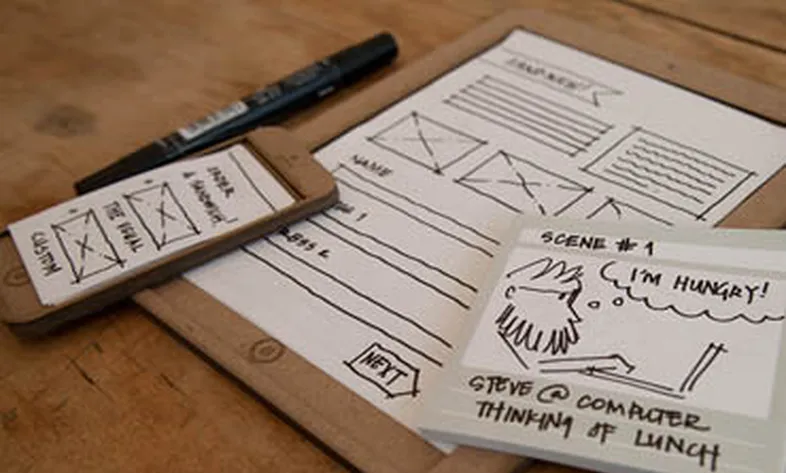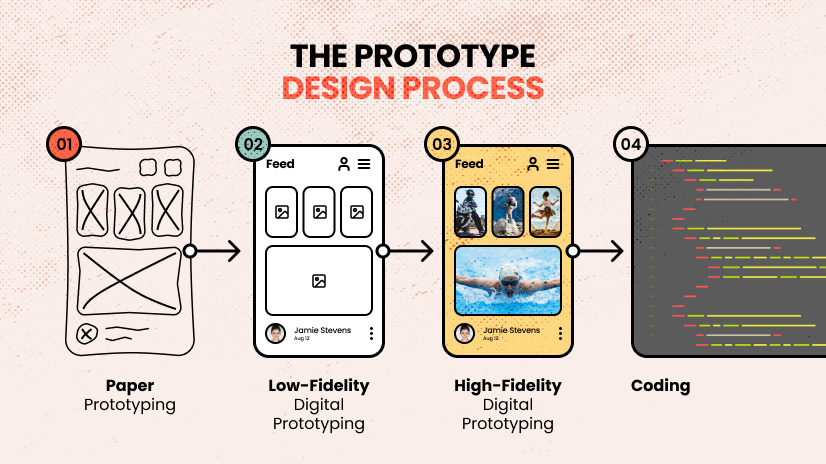Guide to Setting Up Website Email on Mobile and Computer
Follow the guide to set up your domain email on any device or OS, including both smartphones and computers, quickly and easily.

Prototype means a basic design without graphics of anything such as a website, application, industrial equipment, etc.
What is a prototype? In general, it means a preliminary design without graphics of anything such as a website, application, industrial equipment, etc.
Join us today to introduce prototypes for websites and applications.
The first example of your site or application can be a prototype.
A design without graphics and implemented on paper.
You may wonder why the initial site design needs to be drawn on paper.
While prototyping a site or application is not difficult, implementing and designing it in the web world can be very complex.
Therefore, implementing its prototype, due to its visual nature, even without graphics, creates a better understanding of the designer's and client's ideas and instills a better sense of its implementation.
Prototyping is one of the key concepts in the product design process, which is very important in this field.
As an early example of a product, a prototype helps designers and developers turn their ideas into a reality and through it, improve and optimize the product.
Using prototypes in the product design process is important for several reasons.
First, prototyping allows designers to test their ideas in practice and learn about the actual performance of the product in front of its customers and users.
This helps them identify product flaws and weaknesses and improve them in later design stages.
Secondly, prototyping allows development teams to easily implement ideas and required changes using a working example of the product, and quickly achieve desired results.
This increases productivity and reduces product development costs.
Also, prototypes allow customers and end users of the product to get acquainted with a workable example of the product and provide their comments and feedback before its official launch.
You may not want to use the prototype method, so you define your mental plan for the employer, but pay attention to whether the employer understands what you mean or thinks the same way you think about the plan. Until the original plan is implemented, there is always the risk that the employer does not understand what you mean correctly, or vice versa.
But if you draw the initial design of the site on paper, you not only share your mental plan with the client, but also give the client time to think, or UX (user experience), about the design.
The secret behind a prototype is to make the employer think, and you should make the most of this opportunity.
As you know, one of the characteristics of a good site is that it is user-friendly, and one of the characteristics of a user-friendly website is easy access to links and content.
So, since you don't have the employer's business information, you can base the initial design on user-friendliness using a prototype and a little inquiry.

A prototype is an early example of a product or service that is used to evaluate and test its functionality and capabilities.
These samples are usually produced quickly and at low cost so that they can quickly try out different ideas and designs and help improve the product.
One of the advantages of using prototyping in product development is that this method helps development teams quickly turn their ideas into action and improve their products through the feedback they receive.
Also, by using a prototype, you can easily identify and fix product bugs and problems before launching them to the market.
However, using prototypes also comes with some disadvantages.
One of the main disadvantages of this method is the high costs of preparing and producing prototypes.
Also, the time-consuming process of preparing and testing prototypes can be one of the problems with this method.
Furthermore, prototypes may not be able to meet the real needs of users well due to lack of sufficient accuracy and quality.
However, considering the advantages and disadvantages of using prototypes in product development, it can be said that this method is an effective tool for improving the product development process.
Because prototypes help development teams quickly test and improve their ideas, this method can help reduce the risks and costs associated with product development.
On the other hand, this method must be used carefully and with sufficient knowledge to avoid its disadvantages and achieve the best possible results.
Prototypes are usually designed as small models or interactive examples of a product or service that show users what the final product will look like.
Using prototypes in the design and development process of digital products and services helps improve the user experience.
By showing users an interactive example of the product, designers can receive useful feedback and take necessary steps to improve them.
This helps reduce errors and additional costs in the development process and increases product quality and efficiency.
Prototypes also help design and development teams try out different ideas and solutions and choose the best option.
By creating and evaluating different prototypes, teams can quickly reach the right decisions and quickly move to the final product development phase.
Famous companies like Apple, Google, and Amazon use prototypes to develop and improve their products.
For example, Apple used prototypes to evaluate different designs and features before launching the iPhone.
This action helped them bring high-quality, high-performance products to the market.
Google also uses prototypes to develop its new services.
For example, before launching Google Maps, the company used prototypes to evaluate its maps and various features.
This action helped them launch a successful and popular service.
Amazon also uses prototypes to develop and improve its systems.
For example, before introducing Amazon Prime, the company used prototypes to evaluate express shipping and delivery systems.
This action helped them launch a successful service and positive feedback from customers.
Overall, prototypes are an effective tool for companies to improve their ideas and products and get customer feedback.
Using prototypes can help companies bring high-quality, high-performance products and services to market and win the competition.
Our experience shows that if you prototype your project, whether it's a small or large project, your work speed will increase dramatically and you'll deliver something to the customer that they need, not your misconception.
Source: Itroz Blog


Follow the guide to set up your domain email on any device or OS, including both smartphones and computers, quickly and easily.

This guide is useful for automatically forwarding your website emails set up on your domain to other email accounts, such as Gmail and others.

Step-by-step guide to install Thunderbird on macOS; download, setup, and manage multiple email accounts easily and efficiently.
Comments (0)